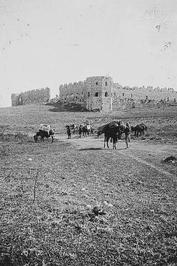
This enclosure was Fortress Antonia.
Much can be gleaned from a careful reading of Acts 21 to 23. Here are several points that reveal some facts about the position, size and importance of the Antonia Fortress.
- It must be seen that the temple was BELOW the fortress as the soldiers ran down to the temple to attend to the fracas (Acts 21:32)
- There were stairs from the temple area leading up to the ‘barracks’ area (Greek παρεμβολή…parembole which is a MILITARY term meaning 'a throwing in beside (juxtaposition), i.e., (specially), battle-array, encampment or barracks' and variously translated fortress, camp, castle, barracks). Clearly description indicates something built (thrown up or erected) alongside something else. That something else was the temple below it. The mob near the temple was so violent that Paul had to be carried by the soldiers. He then addressed the crowd from these stairs.
- From these stairs, Paul was then brought ‘into’ the fortress to be examined by scourging (Acts 22:24). He escaped scourging by appeal to his Roman citizenship.
- The next day, Paul was brought down to the council of the chief priests (Acts 22:30).
- The plot by 40 Jews to kill Paul was to have him brought down again from the fortress (Acts 23:20).
- To accompany Paul to Antipatris and on to Caesarea the commander ordered centurians to prepare….wait for it, 200 soldiers, 200 spearmen and 70 horsemen (Acts 23:23). The 400 apparently returned from Antipatris and the 70 went on with Paul to Caesarea (vv. 31-32). Incidentally, Antipatris itself (see pictures) was a reasonably substantial fortress, also built by Herod the Great and it’s after the same Romanesque style as Antonia, in miniature. He named it for his father Antipater.

So—what is the emerging picture? The fortress is above the temple; the fortress houses a large contingent of specialist troops—soldiers, spear-men, horsemen AND many horses. Seventy would have by no means exhausted the supply of horses (no commander would leave his key asset so impoverished of defence), yet even 70 would occupy at least 2 metres x 4 meters of stable room each, meaning at least 140 linear meters. The Fortress Antonia was huge and accommodated the 10th Roman Legion, comprising 10 cohorts of 500 men each! There is only one place at Jerusalem that would accommodate them. It is the large nearly rectangular enclosure that later mistakenly became known as the Temple platform enclosure on what then became known as ‘Temple Mount.’ (On its long sides it is approximately 400 and 460 meters and the short sides about 300 and 250 each).
 RSS Feed
RSS Feed
